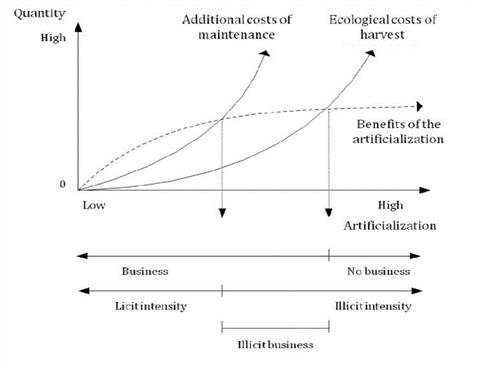Artificialization is defined as a way to apply a certain amount and kind of technology to transform the ecosystem. The resulting ecosystem transformation is a function of the technical inputs. Thus, the end result could express the main functions. One of them is the anthropic benefits brought about as a consequence of this transformation. Still, there is a cost associated with the work inputs applied to the ecosystem.
In general, and consistent with the degree of artificialization the cost increases significantly in vulnerable ecosystems. In contrast, the benefits of marginal ecosystems usually increase very little compared with the degree of artificialization. If this case were to happen, both functions would never intersect. As a consequence this extreme vulnerable ecosystem should not be artificialized at all, being necessary to preserve them in a natural state.
Then again, there are highly stables ecosystems where the additional costs to keep them sustainable are insignificant, but the output benefits of artificialization are high. In this case the degree of sustainable artificialization could be immense.
Under usual condition, namely ecosystems which are not extremely vulnerable nor highly stable, there is an intermediate degree of potential sustainable artificialization (Figure 9). At the right side of the figure, the artificialization costs are greater than the benefits, and thus, the degree of transformation should be no higher than this magnitude. In contrast, at the left side, the cost is lower than the benefits, so it is fine to transform the landscape up to this magnitude. This defines the artificialization for the sustainable cultural landscape construction.
|
Fig. 9. Cost-benefit relation from artificialization in landscape transformation, for an ecosystem of intermediate vulnerability [23]. |




